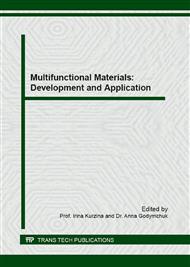[1]
W. Meyer, T.G. Mitchell, E.Z. Freedman, R. Vilgalys, Hybridization probes for conventional DNA fingerprinting used as single primers in the polymerase chain reaction to distinguish strains of Cryptococcus neoformans, J. Clin. Microbiol. 31 (1993).
DOI: 10.1128/jcm.31.9.2274-2280.1993
Google Scholar
[2]
E. Zietkiewicz, A. Rafalski, D. Labuda, Genome fingerprinting by simple sequence repeat (SSR) – anchored polymerase chain reaction amplification, Genomics. 20 (1994) 176-183.
DOI: 10.1006/geno.1994.1151
Google Scholar
[3]
J.G.K. Williams, A.R. Kubelik, K.J. Livak, J.A. Rafalski, S.V. Tingey, DNA polymorphisms amplified by arbitrary primers are useful as genetic markers, Nucleic Acids Res. 18 (1990) 6531-6535.
DOI: 10.1093/nar/18.22.6531
Google Scholar
[4]
D. Tautz, Hypervariability of simple sequences as a general source for polymorphic DNA markers, Nucleic Acids Res. 17 (1989) 6463-6471.
DOI: 10.1093/nar/17.16.6463
Google Scholar
[5]
P. Vos, R. Hogers, M. Bleeker, M. Reijans, T. van de Lee, M. Hornes, A. Frijters, J. Pot, J. Peleman, M. Kuiper, M. Zabeau, AFLP: a new technique for DNA fingerprinting, Nucleic Acids Res. 11 (1995) 4407-4414.
DOI: 10.1093/nar/23.21.4407
Google Scholar
[6]
M.Z. Galvan, B. Bornet, P.A. Balatti, M. Branchard, Inter simple sequence repeat (ISSR) markers as a tool for the assessment of both genetic diversity and gene pool origin in common bean (Phaseolus vulgaris L. ), Euphytica. 132 (2003) 297-301.
DOI: 10.1023/a:1025032622411
Google Scholar
[7]
M. Korbin, A. Kuras, E. Urawicz, Fruit plant germplasm characterisation using molecular markers generated in RAPD and ISSR PCR, Cell Mol. Biol. Lett. 7, 2B (2002) 785-794.
Google Scholar
[8]
W.P. Yang, A.C. Oliveira, I. Godwin, K. Schertz, J.L. Bennetzen, Comparison of DNA marker technologies in characterizing plant genome diversity: variability in Chinese sorghums, Crop Sci. 36 (1996) 1669-1676.
DOI: 10.2135/cropsci1996.0011183x003600060042x
Google Scholar
[9]
S. Cichorz, M. Goska, A. Litwiniec, Miscanthus: genetic diversity and genotype identification using ISSR and RAPD marker, Mol. Biotechnol. 56, 10 (2014) 911-924.
DOI: 10.1007/s12033-014-9770-0
Google Scholar
[10]
D. Metzgar, J. Bytof, C. Wills, Selection against frameshift mutations limits microsatellite expansion in coding DNA, Genome Res. 10 (2000) 72-80.
Google Scholar
[11]
Y. Wang, M. Chen, H. Wang, J. Wang, D. Bao, Microsatellites in the Genome of the Edible Mushroom, Volvariella volvacea, BioMed Res. Int., 2014, Available at: http: /www. ncbi. nlm. nih. gov/pmc/articles/PMC3915763/pdf/BMRI2014-281912. pdf.
DOI: 10.1155/2014/281912
Google Scholar
[12]
J. Huang, Y. Li, L. Du, B. Yang, F. Shen, H. Zhang, Z. Zhang, X. Zhang, B. Yue, Genome-wide survey and analysis of microsatellites in giant panda (Ailuropoda melanoleuca), with a focus on the applications of a novel microsatellite marker system, BMC Genomics, 2015, Available at: http: /www. biomedcentral. com/content/pdf/s12864-015-1268-z. pdf.
DOI: 10.1186/s12864-015-1268-z
Google Scholar
[13]
M. A. Latif, M. M. Rahman, M. E. Ali, S. Ashkani, M.Y. Rafii, Inheritance studies of SSR and ISSR molecular markers and phylogenetic relationship of rice genotypes resistant to tungro virus, CR. Biol. 336, 3 (2013) 125-133.
DOI: 10.1016/j.crvi.2012.12.002
Google Scholar
[14]
T. J. Givnish, G. J. Bean, M. Ames, S. P. Lyon, K. J. Sytsma, Phylogeny, floral evolution, and inter-island dispersal in Hawaiian Clermontia (Campanulaceae) based on ISSR variation and plastid spacer sequences, PLoS One, 2013, Available at: http: /www. ncbi. nlm. nih. gov/pmc/articles/PMC3642221/pdf/pone. 0062566. pdf.
DOI: 10.1371/journal.pone.0062566
Google Scholar
[15]
L. Zande, R. Bijlsma, Limitation of the RAPD technique in phylogeny reconstruction in Drosophila, J. Evolution. Biol. 8 (1995) 645-656.
DOI: 10.1046/j.1420-9101.1995.8050645.x
Google Scholar
[16]
R. Kalendar, T. Grob, M. Regina, A. Suoniem, A. Schulman, IRAP and REMAP: Two new retrotransposon-based DNA fingerprinting techniques, Theor. Appl. Genet. 98 (1999) 704-711.
DOI: 10.1007/s001220051124
Google Scholar
[17]
D.L. Hyndman, M. Mitsuhashi, PCR primer design, Methods Mol. Biol. 226 (2003) 81-88.
Google Scholar
[18]
K.H. Roux, Optimization and troubleshooting in PCR, PCR Meth. Appl. 4 (1995) 185-194.
Google Scholar


